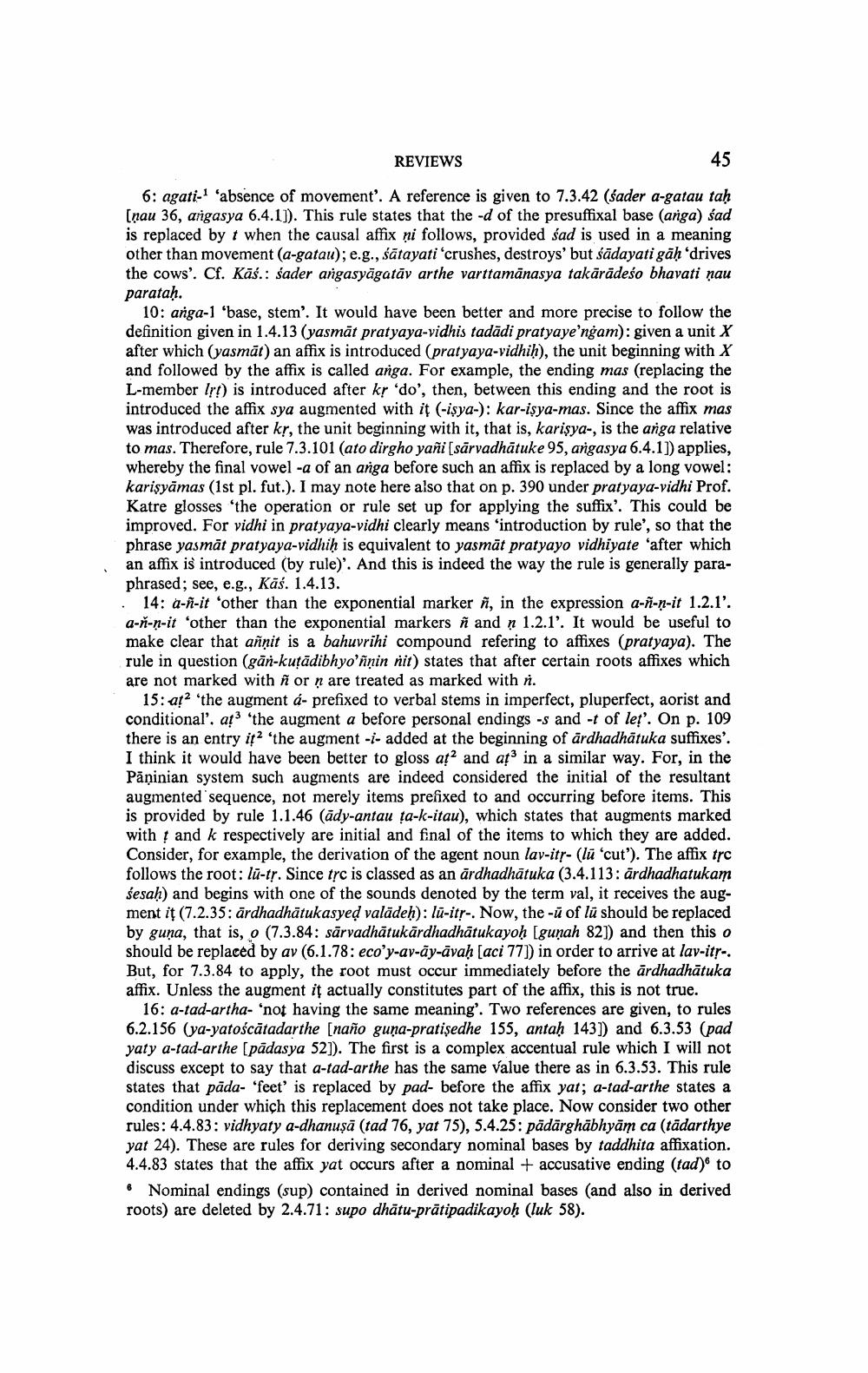Book Title: Reviews Of Different Books Author(s): Publisher: View full book textPage 3
________________ REVIEWS 45 6: agati-1 'absence of movement'. A reference is given to 7.3.42 (sader a-gatau tah [nau 36, argasya 6.4.1]). This rule states that the -d of the presuffixal base (anga) sad is replaced by t when the causal affix ni follows, provided sad is used in a meaning other than movement (a-gatau); e.g., satayati'crushes, destroys' but sadayati gah drives the cows'. Cf. Kas.: sader angasyagatav arthe varttamanasya takaradeso bhavati nau paratah. 10: arga-1 'base, stem'. It would have been better and more precise to follow the definition given in 1.4.13 (yasmat pratyaya-vidhis tadadi pratyaye'ngam): given a unit X after which (yasmat) an affix is introduced (pratyaya-vidhih), the unit beginning with X and followed by the affix is called anga. For example, the ending mas (replacing the L-member lrt) is introduced after kr 'do', then, between this ending and the root is introduced the affix sya augmented with it (-isya-): kar-isya-mas. Since the affix mas was introduced after kr, the unit beginning with it, that is, karisya-, is the anga relative to mas. Therefore, rule 7.3.101 (ato dirgho yani (sarvadhatuke 95, angasya 6.4.1]) applies, whereby the final vowel -a of an anga before such an affix is replaced by a long vowel: karisyamas (1st pl. fut.). I may note here also that on p. 390 under pratyaya-vidhi Prof. Katre glosses 'the operation or rule set up for applying the suffix'. This could be improved. For vidhi in pratyaya-vidhi clearly means 'introduction by rule', so that the phrase yasmat pratyaya-vidhih is equivalent to yasmat pratyayo vidhiyate 'after which an affix is introduced (by rule)'. And this is indeed the way the rule is generally paraphrased; see, e.g., Kas. 1.4.13. * 14: a-n-it 'other than the exponential marker n, in the expression a-n-n-it 1.2.1'. a-n-n-it 'other than the exponential markers n and n 1.2.1'. It would be useful to make clear that annit is a bahuvrihi compound refering to affixes (pratyaya). The rule in question (gan-kutadibhyo'nnin nit) states that after certain roots affixes which are not marked with n or n are treated as marked with n. 15: ata 'the augment a- prefixed to verbal stems in imperfect, pluperfect, aorist and conditional'. at 'the augment a before personal endings -s and -t of let'. On p. 109 there is an entry if2 'the augment -i- added at the beginning of ardhadhatuka suffixes'. I think it would have been better to gloss ata and at3 in a similar way. For, in the Paninian system such augments are indeed considered the initial of the resultant augmented sequence, not merely items prefixed to and occurring before items. This is provided by rule 1.1.46 (ady-antau ta-k-itau), which states that augments marked with t and k respectively are initial and final of the items to which they are added. Consider, for example, the derivation of the agent noun lav-its- (lu 'cut'). The affix trc follows the root: lu-tr. Since trc is classed as an ardhadhatuka (3.4.113: ardhadhatukam sesah) and begins with one of the sounds denoted by the term val, it receives the augment it (7.2.35: ardhadhatukasyed valadeh): lu-its-. Now, the -u of lu should be replaced by guna, that is, o (7.3.84: sarvadhatukardhadhatukayoh (gunah 82]) and then this o should be replaced by av (6.1.78: eco'y-ay-ay-avah (aci 77]) in order to arrive at lav-its-. But, for 7.3.84 to apply, the root must occur immediately before the ardhadhatuka affix. Unless the augment is actually constitutes part of the affix, this is not true. 16: a-tad-artha- 'not having the same meaning'. Two references are given, to rules 6.2.156 (ya-yatoscatadarthe (nano guna-pratisedhe 155, antah 143]) and 6.3.53 (pad yaty a-tad-arthe (padasya 52]). The first is a complex accentual rule which I will not discuss except to say that a-tad-arthe has the same value there as in 6.3.53. This rule states that pada- 'feet' is replaced by pad- before the affix yat; a-tad-arthe states a condition under which this replacement does not take place. Now consider two other rules: 4.4.83: vidhyaty a-dhanusa (tad 76, yat 75), 5.4.25: padarghabhyam ca (tadarthye yat 24). These are rules for deriving secondary nominal bases by taddhita affixation. 4.4.83 states that the affix yat occurs after a nominal + accusative ending (tad) to 6 Nominal endings (sup) contained in derived nominal bases (and also in derived roots) are deleted by 2.4.71: supo dhatu-pratipadikayoh (luk 58).Page Navigation
1 2 3 4 5 6 7 8 9 10 11 12 13 14 15 16 17 18 19 20 21 22 23 24 25 26 27 28 29 30 31 32 ... 38
